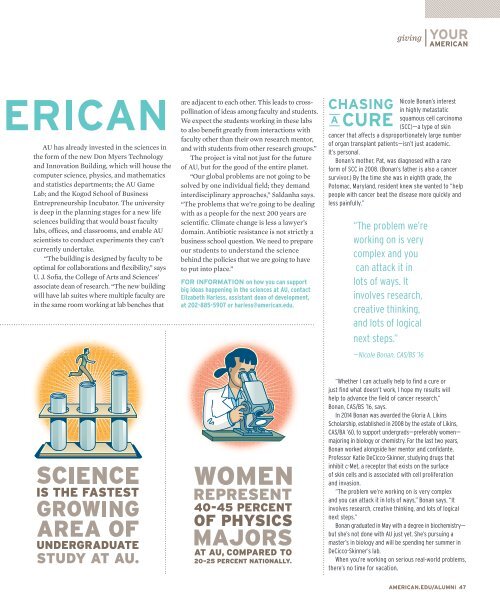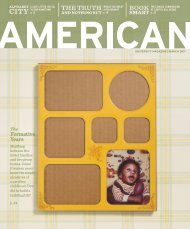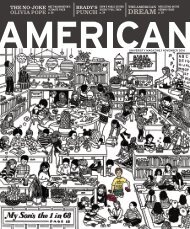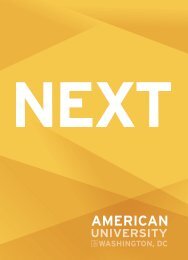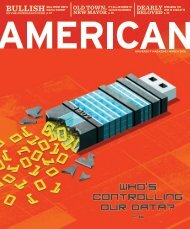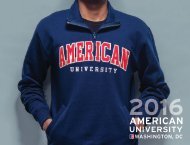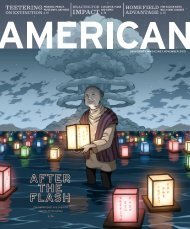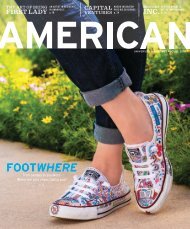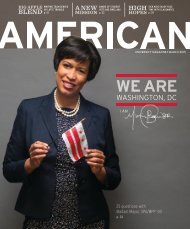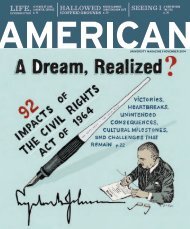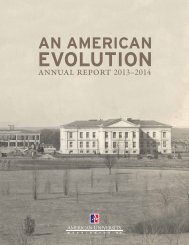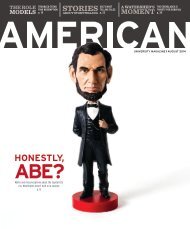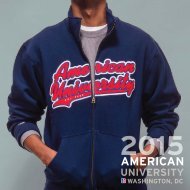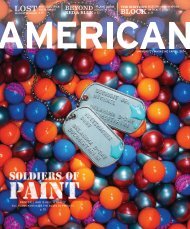American magazine, July 2016
In this issue explore DC street art, run away with the Street Light Circus, meet AU’s Olympic hopefuls, reminisce about commencements past, hop on the Metro to the Smithsonian, and get to know some of AU’s 1,875 Boston transplants. Also in the July issue: 3 minutes on the national parks, 88 years of yearbooks, and a beer quiz.
In this issue explore DC street art, run away with the Street Light Circus, meet AU’s Olympic hopefuls, reminisce about commencements past, hop on the Metro to the Smithsonian, and get to know some of AU’s 1,875 Boston transplants. Also in the July issue: 3 minutes on the national parks, 88 years of yearbooks, and a beer quiz.
You also want an ePaper? Increase the reach of your titles
YUMPU automatically turns print PDFs into web optimized ePapers that Google loves.
giving<br />
AU has already invested in the sciences in<br />
the form of the new Don Myers Technology<br />
and Innovation Building, which will house the<br />
computer science, physics, and mathematics<br />
and statistics departments; the AU Game<br />
Lab; and the Kogod School of Business<br />
Entrepreneurship Incubator. The university<br />
is deep in the planning stages for a new life<br />
sciences building that would boast faculty<br />
labs, offices, and classrooms, and enable AU<br />
scientists to conduct experiments they can’t<br />
currently undertake.<br />
“The building is designed by faculty to be<br />
optimal for collaborations and flexibility,” says<br />
U. J. Sofia, the College of Arts and Sciences’<br />
associate dean of research. “The new building<br />
will have lab suites where multiple faculty are<br />
in the same room working at lab benches that<br />
are adjacent to each other. This leads to crosspollination<br />
of ideas among faculty and students.<br />
We expect the students working in these labs<br />
to also benefit greatly from interactions with<br />
faculty other than their own research mentor,<br />
and with students from other research groups.”<br />
The project is vital not just for the future<br />
of AU, but for the good of the entire planet.<br />
“Our global problems are not going to be<br />
solved by one individual field; they demand<br />
interdisciplinary approaches,” Saldanha says.<br />
“The problems that we’re going to be dealing<br />
with as a people for the next 200 years are<br />
scientific. Climate change is less a lawyer’s<br />
domain. Antibiotic resistance is not strictly a<br />
business school question. We need to prepare<br />
our students to understand the science<br />
behind the policies that we are going to have<br />
to put into place.”<br />
FOR INFORMATION on how you can support<br />
big ideas happening in the sciences at AU, contact<br />
Elizabeth Harless, assistant dean of development,<br />
at 202-885-5907 or harless@american.edu.<br />
Nicole Bonan’s interest<br />
in highly metastatic<br />
squamous cell carcinoma<br />
(SCC)—a type of skin<br />
cancer that affects a disproportionately large number<br />
of organ transplant patients—isn’t just academic.<br />
It’s personal.<br />
Bonan’s mother, Pat, was diagnosed with a rare<br />
form of SCC in 2008. (Bonan’s father is also a cancer<br />
survivor.) By the time she was in eighth grade, the<br />
Potomac, Maryland, resident knew she wanted to “help<br />
people with cancer beat the disease more quickly and<br />
less painfully.”<br />
“The problem we’re<br />
working on is very<br />
complex and you<br />
can attack it in<br />
lots of ways. It<br />
involves research,<br />
creative thinking,<br />
and lots of logical<br />
next steps.”<br />
—Nicole Bonan, CAS/BS ’16<br />
“Whether I can actually help to find a cure or<br />
just find what doesn’t work, I hope my results will<br />
help to advance the field of cancer research,”<br />
Bonan, CAS/BS ’16, says.<br />
In 2014 Bonan was awarded the Gloria A. Likins<br />
Scholarship, established in 2008 by the estate of Likins,<br />
CAS/BA ’60, to support undergrads—preferably women—<br />
majoring in biology or chemistry. For the last two years,<br />
Bonan worked alongside her mentor and confidante,<br />
Professor Katie DeCicco-Skinner, studying drugs that<br />
inhibit c-Met, a receptor that exists on the surface<br />
of skin cells and is associated with cell proliferation<br />
and invasion.<br />
“The problem we’re working on is very complex<br />
and you can attack it in lots of ways,” Bonan says. “It<br />
involves research, creative thinking, and lots of logical<br />
next steps.”<br />
Bonan graduated in May with a degree in biochemistry—<br />
but she’s not done with AU just yet. She’s pursuing a<br />
master’s in biology and will be spending her summer in<br />
DeCicco-Skinner’s lab.<br />
When you’re working on serious real-world problems,<br />
there’s no time for vacation.<br />
AMERICAN.EDU/ALUMNI 47


